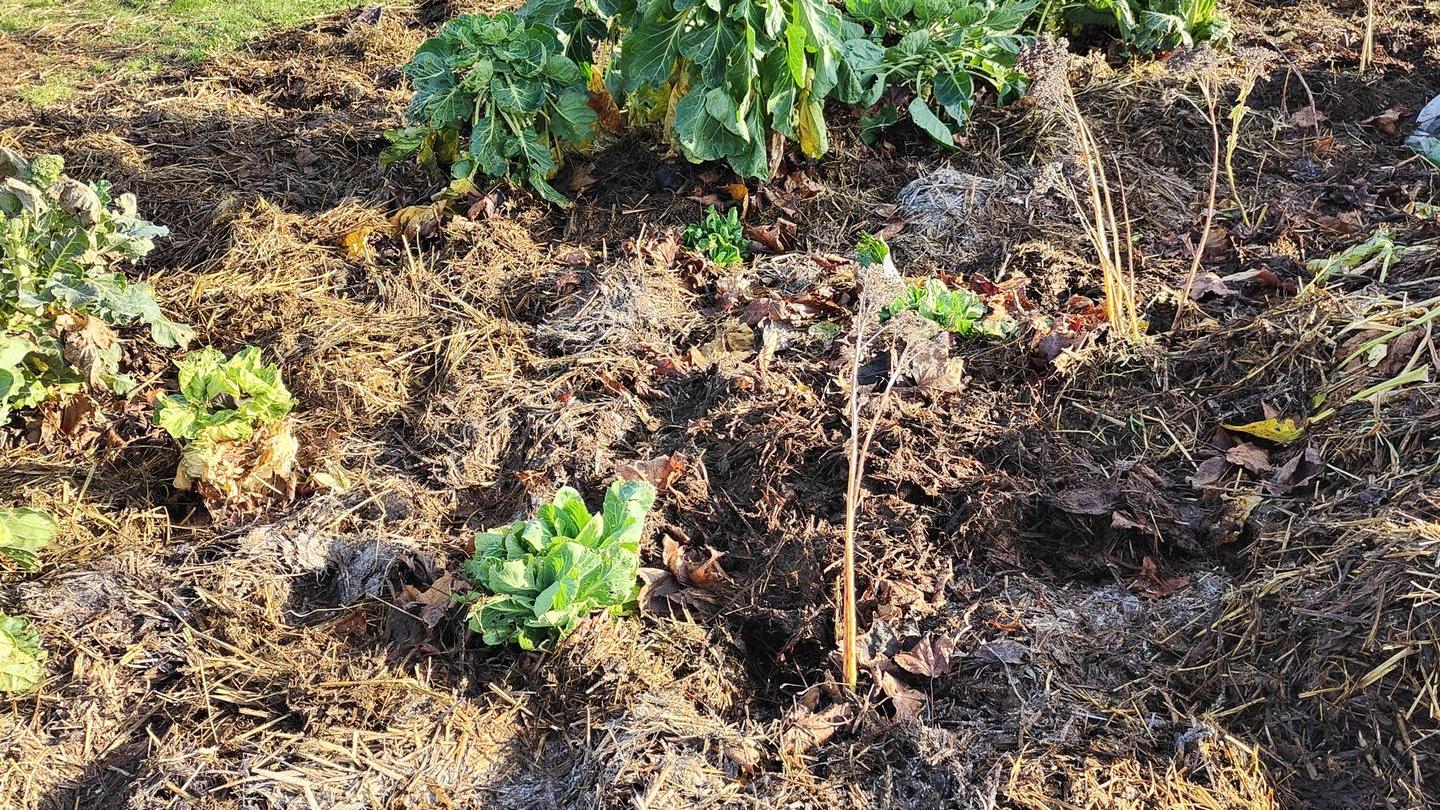This blog is a bit long, I agree, but it is informative for understanding the market gardening aspect of the Radish Company..
(In Italics and on a pink background, you will have the (un)fortunate chance to read my thoughts - with a more proper language than the real ones 😒)
Happy reading!
Prepare the soil for the next season
For the past few weeks, we have been regularly going to get horse manure from an acquaintance in our village. This week, I thought it was time to harvest the last vegetables (leeks, Brussels sprouts, black radishes) and spread the manure on the now bare plots. For those in the know, it's fresh manure, not composted. We'll talk about it more later!
In addition to the manure, we also have several piles of leaves from the garden trees in stock.
Without hesitation, I'm getting started.
- Yesterday, I harvested the last vegetables. I blanched the leeks and Brussels sprouts, and I'm making a delicious, I hope, radish-potato-puree! Recipe coming in our video this Thursday 🤩
- Today, I spread the leaves and the manure.
First the leaves and then the manure... yes, that matters!!!

Then I sit down behind my computer to write this blog and I look for some technical information, like Carbon vs Nitrogen, to complete the blog.
"And s... I still did quite a few stupid things 😒"
Alright! Let's start from the beginning.
By the way, what is manure?
First thing, manure is an amendment and not a fertilizer.
It is important to know that a plant primarily needs three mineral elements: Nitrogen (N), Phosphorus (P), and Potassium (K) to grow. These needs vary from one plant to another, but they are always part of the equation..
A fertilizer aims to directly nourish the plant by providing the mineral elements that are lacking in the soil. Once they are absorbed by the plant, they need to be supplied again.
An amendment modifies and improves the physical structure of the soil, including pH, water retention and aeration of the soil. They are much less rich in minerals than fertilizers and only release them gradually as they degrade, particularly under the action of the numerous living organisms present in the soil.
In (very) brief, an amendment is a very slow fertilizer with lasting effects over the long term.
Fresh or composted manure?
Fresh manure is the one that comes from the b... of the horse or the cow 🤔 while composted manure is fresh manure that is put in a pile so that it heats up until it reaches a temperature sufficient to start the fermentation process..
The advantage of fresh manure is that, being coarser than composted manure, it requires more work from living organisms in the soil to decompose it and therefore multiplies this organic life. On the other hand, in addition to minor inconveniences, it has the major drawback of still containing traces of what the animal has eaten and therefore potentially medicines, dewormers, etc.
It is therefore advisable to spread composted manure because during the composting process, the heat exceeds 50° and kills bacteria, viruses, parasites and other undesirables.
Small recipe for effective composting. You need to...
- ... place the pile of manure on a support - branches, pallets ... - so that the fermentation "juice" flows 😋
- ... turn the manure approximately every 6 weeks so that all its parts reach 50°.
- ... that the temperature remains at 50° for a minimum of 6 weeks for effective sanitation. So it’s longer in winter 🧑🎄
- ... cover the manure to prevent leaching by rainwater.
“And of course, the manure I have is… fresh!”
When to spread manure?
If fresh manure is used, it is necessary...
- ... to spread it in autumn so that it naturally cleans up in contact with the air after a few weeks.
- ... not to bury it for the health reasons mentioned above.
- ... to especially not put it at the foot of already installed plants to avoid burning the roots.
If composted manure is used, it can be spread in the spring at the end of March.
"Gosh! I left some Brussels sprouts with lots of manure around them so they could grow a little longer!"
How to use manure?
If it is fresh, manure will need oxygen to decompose. But at the same time, it can lose up to 50% of its nitrogen through volatilization..
So it is recommended...
- ... either to bury it very lightly - less than 10cm, so that it remains in an aerobic environment ("Yes I wanted to use that word").
- ...or cover it with straw, hay, grass clippings or dead leaves.
For composted manure, it's simpler. If the soil is full of life, we leave it on the surface and let the small creatures take care of it, otherwise, we bury it.
"So cool! I just did the opposite. I put the leaves AND THEN the manure!"
Conclusion

Well!
So it's not quite that!
As long as it was light, I managed to turn over the manure and the dead leaves as best as I could. Tomorrow I will go pull up the remaining Brussels sprouts. Fortunately, all of this was done on the "private vegetable garden" plot.
On the other hand, now it’s a challenge for spring!
We must urgently find a large quantity of manure (cow and horse) so that it is ready for spring. At the same time, we will look for already composted manure..
And finally, we will continue to go get our trailers of fresh manure to spread on a plot that will not be cultivated until later in the season..
“We learn, we share... that’s the Compagnie du Radis 😘”